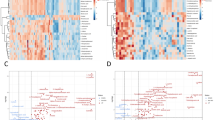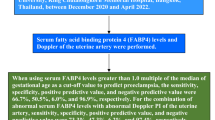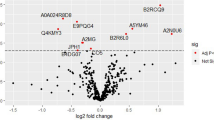Abstract
Preeclampsia is a pregnancy-associated disorder that manifests as a sudden increase in maternal blood pressure accompanied by proteinuria. Because the placenta is a key organ in preeclampsia, we used proteomic and lipidomic analyses to compare placentae from preeclamptic and gestational age matched control pregnancies. Fatty acid binding protein 4 (FABP4), enoyl-CoA dehydrogenase and delta-3,5-delta-2,4-dienoyl-CoA isomerase had altered abundance in preeclamptic placentae compared to controls. FABP4 placental protein and RNA and plasma levels were all increased in early-onset preeclampsia (prior to 28 weeks gestation) compared to controls (6-fold, 3.3-fold and 3.5-fold respectively). After 28 weeks, FABP4 protein in control placenta and plasma increased to the same concentrations as in preeclampsia. Total tetracosapentaenoic acid in preeclamptic placentae was decreased to 0.6 of control levels before 28 weeks. The data indicate a disruption of fatty acid transport and metabolism in the placenta in early onset preeclampsia that is reflected in the maternal plasma.
Similar content being viewed by others
Article PDF
Author information
Authors and Affiliations
Corresponding author
Rights and permissions
About this article
Cite this article
Han, V., Lajoie, G., Ballard, J. et al. Early onset preeclampsia is characterized by altered placental lipid metabolism and a premature increase in circulating FABP4. Nat Prec (2010). https://doi.org/10.1038/npre.2010.4885.1
Received:
Accepted:
Published:
DOI: https://doi.org/10.1038/npre.2010.4885.1



